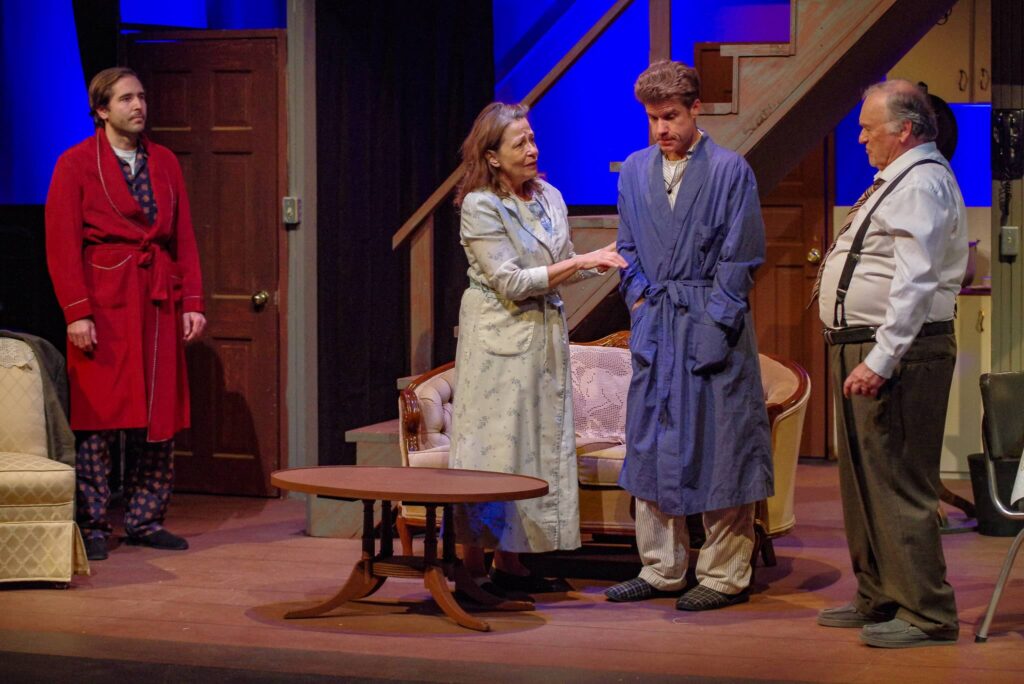REVIEW: Classic play seems more relevant and powerful today

Dundas Little Theatre’s strong production of Death of a Salesman shows its themes of unfettered capitalism, the damaging effects of the pursuit of the American Dream, and the danger of the unchecked male ego resonate even more today than when the play debuted 76 years ago.
Death of a Salesman has been hailed as one of the greatest plays of the 20th century, a notion supported by the fact that it won a Pulitzer Prize for Drama and the Tony Award for Best Play in its premiere run. Still, in a sea of available contemporary choices, some might wonder why the old classic was selected for Dundas Little Theatre’s 2025-2026 season. At 76 years old, Death of a Salesman retains an uncomfortable degree of social relevance as the DLT’s production capably shows. It’s onstage now until Nov. 16.
The show’s synopsis on the Dundas Little Theatre website concludes with a nod to the play’s continuing relevance: “Set in Brooklyn in the aftermath of WWII, this play tracks the tragic decline of Willy Loman, a salesman who has devoted his career to one company but is now unable to meet his quotas due to age, exhaustion, and mental decline. The play exposes the unrealistic and damaging expectations fostered by the so-called American Dream, and seems to become more relevant with each passing year.”
The play was penned, of course, by an American literary heavyweight, playwright Arthur Miller, who was responsible for other famous works including The Crucible, All My Sons, and A View from the Bridge. Death of a Salesman was partly inspired by the life and tragic suicide of his uncle, Manny Newman, who was a salesman sharing a number of similarities with the play’s protagonist, Willy Loman. The two-act tragedy ran for over 700 performances in its premiere run, has been revived on Broadway five times, adapted for film 10 times, and surpassed 11 million copies sold by the end of the last century.
The play’s themes include some very modern issues, indeed, from generational trauma and toxic masculinity (though those phrases had not yet been coined), the mythology of the American Dream, the anatomy of truth, the promise and pressures of capitalism, ageism, and mental illness.

It’s this last theme that captured director Matthew Willson’s attention. As he says in his notes in the playbill, “Arthur Miller first considered titling Death of a Salesman ‘The Inside of his Head’...I was drawn to that idea. For me, the play is not primarily about success, failure, or wealth — it is about the fragile state of a man’s inner world.”
“At its core, Willy Loman’s story is a meditation on men’s mental health and the pressures of midlife. The American Dream may provide the backdrop, but I believe Willy would struggle no matter how much he had,” Willson explains. “His turmoil comes from within: relentless self-doubt, unspoken pain, and the longing to be seen and valued. These themes are as urgent today as when Miller first set them on paper.”
Death of a Salesman moves back and forth in time, mostly following the stories, dreams, and increasingly disjointed recollections of Willy Loman. If Loman expects his listeners to take his accounts at face value, perhaps just livened up with some dramatic flourishes, we come to see that he is a singularly unreliable narrator of his life, which is juddering towards a tragic end.
More than once I found myself reminded of U.S. President Donald Trump, a man who spins lies and fantastical stories in which he is always the hero, always the “big man.” The crowds that come to celebrate him are always the biggest, the things he builds are always the best; he is always the strongest, the smartest, the most worthy. Like Trump, Loman has built an almost impenetrable armour for himself that proves him to be a “winner,” and he exists in a parallel universe of sorts, needing to believe his delusions at all costs.

Returning DLT actor Bruce Edwards gives a tremendous performance as Willy Loman in this production, showing the harrowing devolution of a hard-working man as the illusions he’s built up about his life begin to give way. He is psychologically trapped in a mythology of his own making, and where once these aggrandizing stories may have provided hope or an ego boost or the will to fight another day, he becomes unmoored and confused when he is confronted by his fictions. He shows so viscerally, in his increasingly agitated speech and physicality, the crumbling of one man’s uncertain hold on reality. Through his powerful and vulnerable performance, sweating and wild-eyed and shambling jerkily, a rapidly building sense of tension and anxiety grows as the story careens to a terrible climax.
The beating heart of the story is the Loman family, particularly the marriage between Willy and his wife Linda, played by another DLT veteran and talented local actor Christine Hopkins. Last season she was a stand-out in a very different role in another production, Village Theatre Waterdown’s Sequence.
Here, she beautifully embodies Linda as an anxious yet doggedly optimistic helpmate to Willy as befits those of the Greatest Generation, who came of age during the Second World War. More than once I thought of the dynamic of my own grandparents from the same era: my grandmother, who was nervous and quiet and satisfied to let my grandfather have dominion over his “castle,” sometimes ordered around and talked over by my grandfather in a way that Hopkins and Edwards bring to life.
More than once as well, I thought of Edith and Archie Bunker of TV’s All in the Family, Edith in Hopkins’ nervous physicality and Edwards with his overbearing, domineering bellows. All this points to what I thought was a very realistic portrayal of men and women of the era.

Above all, though, it’s only Linda who is able to slow the pace of Willy’s descent; the slight and gentle Linda becomes a lioness, even against her adult sons, in protection of her husband. It’s Linda who keeps the household accounts and is the quiet strength of her family. And it’s Linda whose fate will be irrevocably changed should Willy’s grip on reality slip, as it inevitably does.
A third performance which must be mentioned is that of Jeff Giles as Biff Loman, elder son of Willy and Linda, and Willy’s “golden boy.” He’s introduced as an individual who hasn’t found his niche despite drifting from one job to the next; he’s an underachiever. This is despite his promise as a young man who was a popular and handsome sports hero. At first, his desire to live on a ranch and avoid the rat race seems to show, at worst, a lack of ambition and, at best, a wildly different set of values than those that drive his father.
As the story unfolds, and Willy is revealed to have been omitting key elements from his life as a travelling salesman, what seems to be a personality or generational clash takes on a more traumatic tone. Willy’s breakdown is paralleled by another by his son Biff, and in Act Two, Giles is riveting as he desperately grasps his father while kneeling, broken, at his feet.
The cast of Dundas Little Theatre’s Death of a Salesman numbers about a dozen actors, and each of them contribute very well to the success of the production. This lends consistency and ballast within a story that otherwise spotlights psychological breakdown and the crumbling of illusions.
The costuming is top notch and historically faithful, and the set design is inventive and makes the most of the available space. I was impressed by the sturdiness of the two-floor set design; there was nary a wobble as the actors tramped up and down the stairs (I was also impressed that none of the cast twisted an ankle or seemed breathless after climbing those stairs).
My only (mild) criticism would be that it was sometimes difficult to see the faces of the actors when they were performing “upstairs,” due to the lack of lighting.
Opening night attendance was hampered by an unfortunate double whammy: Trick-or-treating and Game 6 of the World Series. Particularly if you’ve never seen this classic play staged (as I hadn’t), do lend this production your support.

NEED TO KNOW
Death of a Salesman
Continues Nov. 7, 8, 14 & 15 at 8 p.m.
and Nov. 9 & 16 at 2 p.m.
Dundas Little Theatre
Garstin Centre for the Arts
37 Market St. S., Dundas
Tickets: $27 (general admission); students & seniors: $22 matinee tickets with I.D.
Buy here: box office: 905-627-5266 or online











